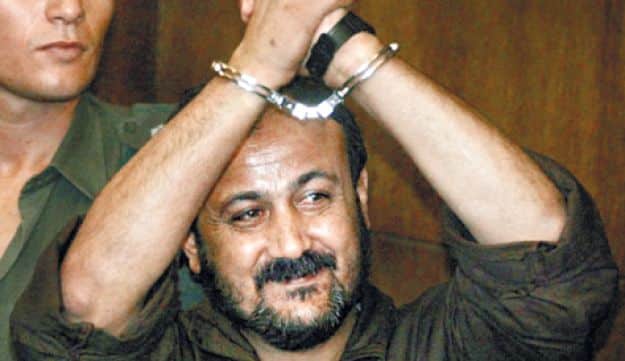Last week, the New York Times hired Bret Stephens, former Wall Street Journal columnist and editor-in-chief of the Jerusalem Post, in a move that many saw as perhaps heralding in a period of more balanced reporting from the paper commonly known as the New York Slimes.
 But any elation over his appointment has been dampened after the Times went really low, even by their own low standards: publishing an editorial by arch terrorist Marwan Barghouti and describing him as a “Palestinian leader and parliamentarian” – without any reference to his murderous legacy – at the bottom of the piece.
But any elation over his appointment has been dampened after the Times went really low, even by their own low standards: publishing an editorial by arch terrorist Marwan Barghouti and describing him as a “Palestinian leader and parliamentarian” – without any reference to his murderous legacy – at the bottom of the piece.
Sure, they later added in this editor’s note:
Editors’ Note: April 17, 2017
This article explained the writer’s prison sentence but neglected to provide sufficient context by stating the offenses of which he was convicted. They were five counts of murder and membership in a terrorist organization. Mr. Barghouti declined to offer a defense at his trial and refused to recognize the Israeli court’s jurisdiction and legitimacy
But only after they were hammered by many prominent people and organizations – or at least those who have a problem with providing a platform for a terrorist without disclosing he is a terrorist.
Just as a reminder, here is more on this “Palestinian leader and parliamentarian”:
Marwan Barghouti is currently serving 5 life sentences for orchestrating three shooting attacks that killed 5 people: one attack in Jerusalem (June 12, 2001) in which Greek monk Tsibouktsakis Germanus was murdered by terrorist Ismail Radaida and another unidentified terrorist, another attack at a gas station in Givat Zeev near Jerusalem (Jan. 15, 2002) in which Yoela Hen, 45, was murdered by terrorists led by Mohammed Matla, and one shooting and stabbing attack at the Sea Food Market restaurant in Tel Aviv (March 5, 2002) in which Eli Dahan, 53, Yosef Habi, 52, and Police Officer Sergeant-Major Salim Barakat, 33, were murdered by terrorist Ibrahim Hasouna. When arrested by Israel in 2002, Barghouti headed the Tanzim (Fatah terror faction). After he was convicted and imprisoned, he was re-elected member of the Palestinian Authority parliament.
I know I’m a bit late to the party with this story, but I have something to add. Not only have the New York Times mislead readers with their description of Barghouti, but they have allowed him to deceive their readers with the content of his piece, which he uses to explain why he is “going on a hunger strike.”
Having spent the last 15 years in an Israeli prison, I have been both a witness to and a victim of Israel’s illegal system of mass arbitrary arrests and ill-treatment of Palestinian prisoners. After exhausting all other options, I decided there was no choice but to resist these abuses by going on a hunger strike.
Some 1,000 Palestinian prisoners have decided to take part in this hunger strike, which begins today, the day we observe here as Prisoners’ Day. Hunger striking is the most peaceful form of resistance available. It inflicts pain solely on those who participate and on their loved ones, in the hopes that their empty stomachs and their sacrifice will help the message resonate beyond the confines of their dark cells.
Terror survivor and occasional Israellycool contributor Kay Wilson has brought to our attention the following video from Israel’s channel 2 a number of years ago, showing the conditions of palestinian prisoners in Israeli jails.
Kay has identified the parts in particular to note:
3’15 – TV with 10 channels in their cell
4’40 – Monthly pocket money from the Palestinian Authority. In addition to an average monthly murder stipend of about 4,000 Shekels that goes to their families.
4’50 – Table Tennis. (Yes, you read that correctly).
5’54 – Private storeroom of food always on hand.
6’30 – Prison official says that they eat this food when on “hunger strike,” and that hunger-strike only means refusing the 3 daily prison meals.
9’15 – Free dental clinic (no such thing for Israelis).
9’20 – Immediate appointments in hospitals should the need arise. (Something that many Israelis can only dream of).
9’50 – Community Islamic prayers.
10’50 – Visits with families and lawyers.
13’01 – Murderers gathering in their cell to tuck into humus and snacks that are always available should the need to hunger strike arise.
15’15 – Library. Terrorists get a free education and study for degrees in jail.
15’45 – Games, BackGammon etc…
15’27 – More food stash, should the need to go on hunger strike arise.
19’17 – One of the most notorious terrorists refuses to be interviewed because “he doesn’t want to be seen as shaved, looked-after and respectable in appearance.” These are his exact words. They have to keep up the public image of Israel supposedly treating them badly.
21’40 – Smaller cell with TV, audio headset, coca-cola, kettle, 2 nice pillows… & despite it all, the terrorist promises that the violence must continue.
https://www.facebook.com/kishkushkay/posts/10154554771598927
Clearly not as Barghouti describes.
The least the Times can do now is report on the true situation in Israeli prisons to undo some of the damage they have done with this op-ed.
Perhaps Bret Stephens can help.



